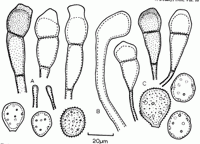|
 Puccinia rara Puccinia rara
BiostatusPresent in region - Indigenous. Endemic
Images (click to enlarge)
Caption: Fig 1 a, Puccinia rara McKenzie, teliospores, urediniospores, and paraphyses. b, P.
crinitae McNabb, paraphysis. c, P. polypogonobia, teliospores and urediniospores.
Specimens mounted in hydrous lactophenol. |
Article: McKenzie, E.H.C. (1980). New graminicolous rust fungi, Puccinia rara sp. nov. and P. polypogonobia sp. nov. New Zealand Journal of Botany 18(3): 335-337 (http://www.rsnz.org/publish/abstracts.php).
Description: Aecia not known. Uredinia µmphigenous, mainly on abaxial surface, orange-yellow,
pulverulent, with colourless thin-walled cylindrical paraphyses. Urediniospores (16-) 21-27 (-28) x (15-)
18-23 (-25) µm, globose or broadly ellipsoid, wall 1.25-1.75 µm thick, pale
yellow, finely and closely echinulate, germ pores 8-10 (-13), scattered. Telia on abaxial
surface, cinnamon-brown. Teliospores (45-) 50-65 (-80) x (15-) 17-20 (-22) µm, constricted
at septum, wall 1-1.5 µm thick at sides, (5.5-) 7.5-10 (-12) µm at apex, smooth, pale
chestnut-brown apically, paler basally, upper cell ellipsoidal or subglobose, lower cell
obovoid; pedicles up to 20 x 6-9 µm, persistent, pale brown.
Notes: Puccinia rara resembles P. crinitae McNabb described on Dichelachne crinita by McNabb
(1962). The urediniospores of the two rusts are similar in shape, but those of P. crinitae are
larger (av. 31 x 27 µm) and usually have more germ pores (10-14). The large capitate
paraphyses of P. crinitae (Fig. lb) are very obvious, whereas P. rara has only small
cylindrical paraphyses. The teliospores of both rusts are similar in shape and size, although
the apical wall of the teliospores of P. crinitae is much narrower (up to 4 µm). Cummins
(1971), who examined the type of P. crinitae, gives larger measurements for the
teliospores than are given by McNabb (1962). The discrepancy is apparently due to the
scarcity of teliospores on the type.
The two rusts show a difference in host range. Records to date show that P. crinitae is
restricted to D. crinita (30 collections), and P. rara mainly to D. rara
(5 collections) and
D. sciurea var. inaeyuiglumis (6 collections), with the one exception (PDD 39790) on D.
crinita.
|